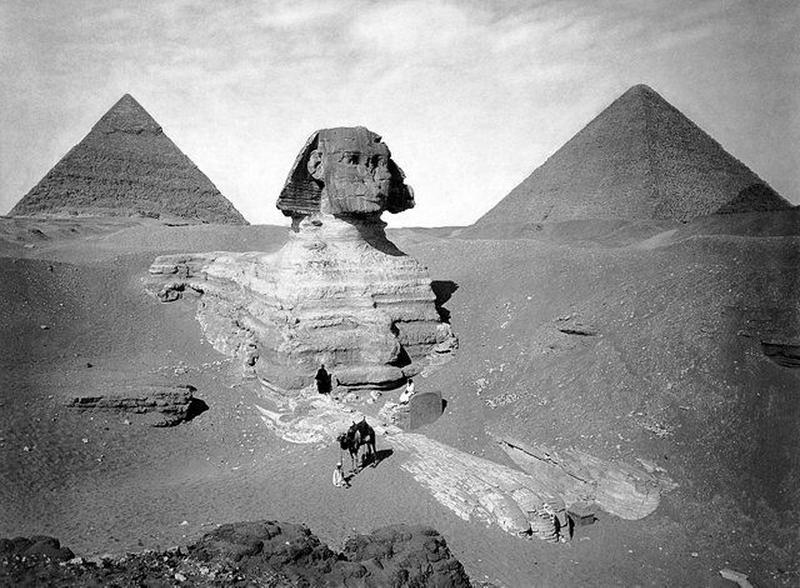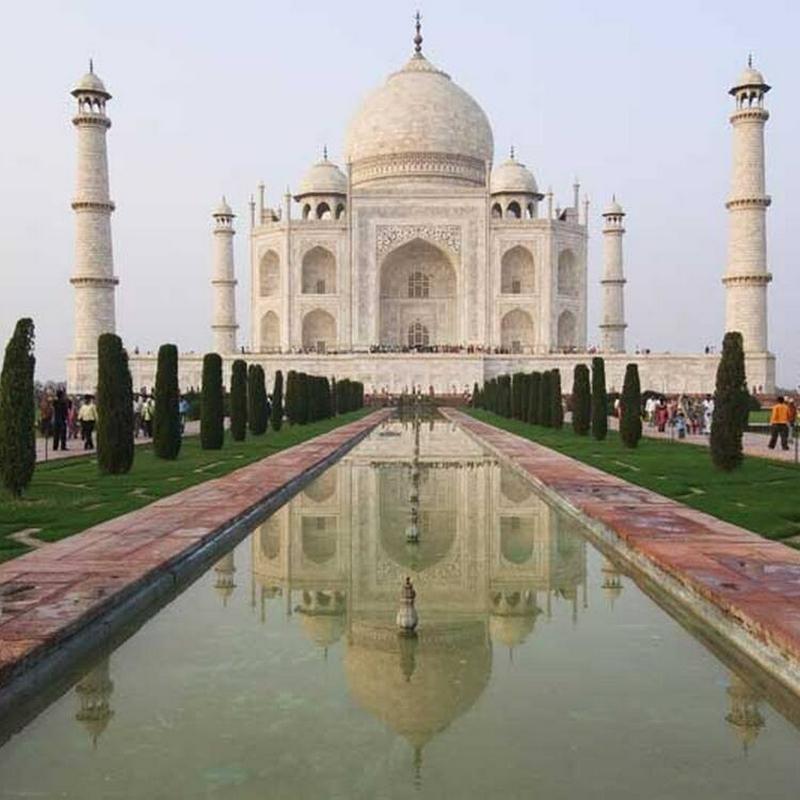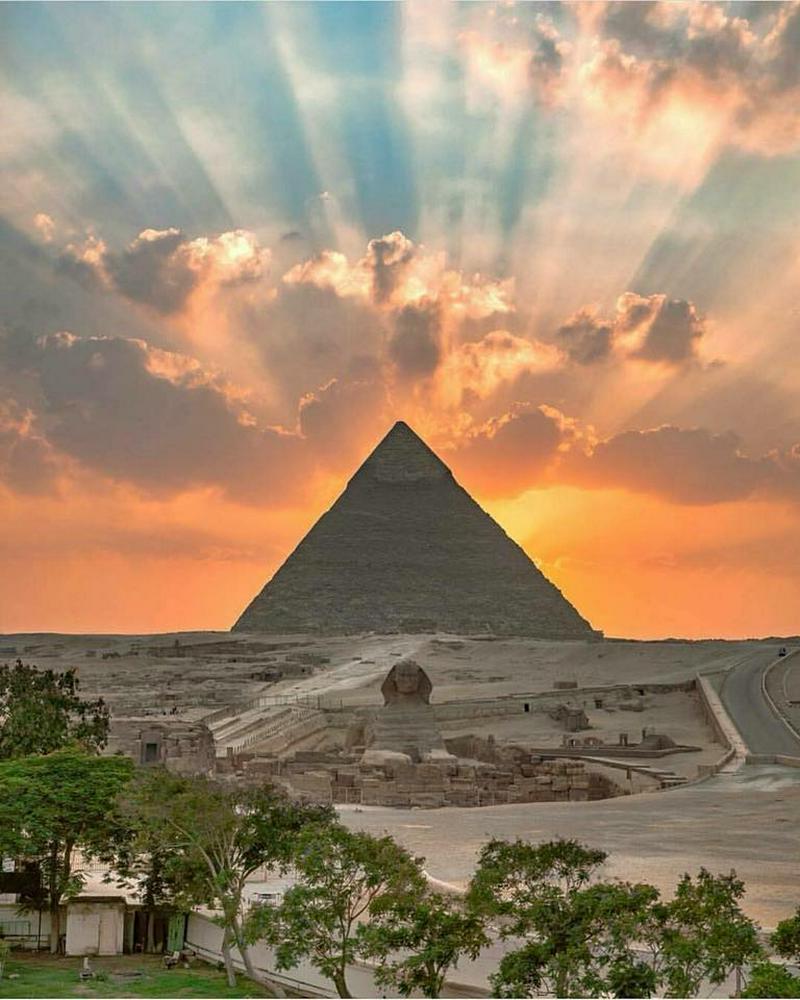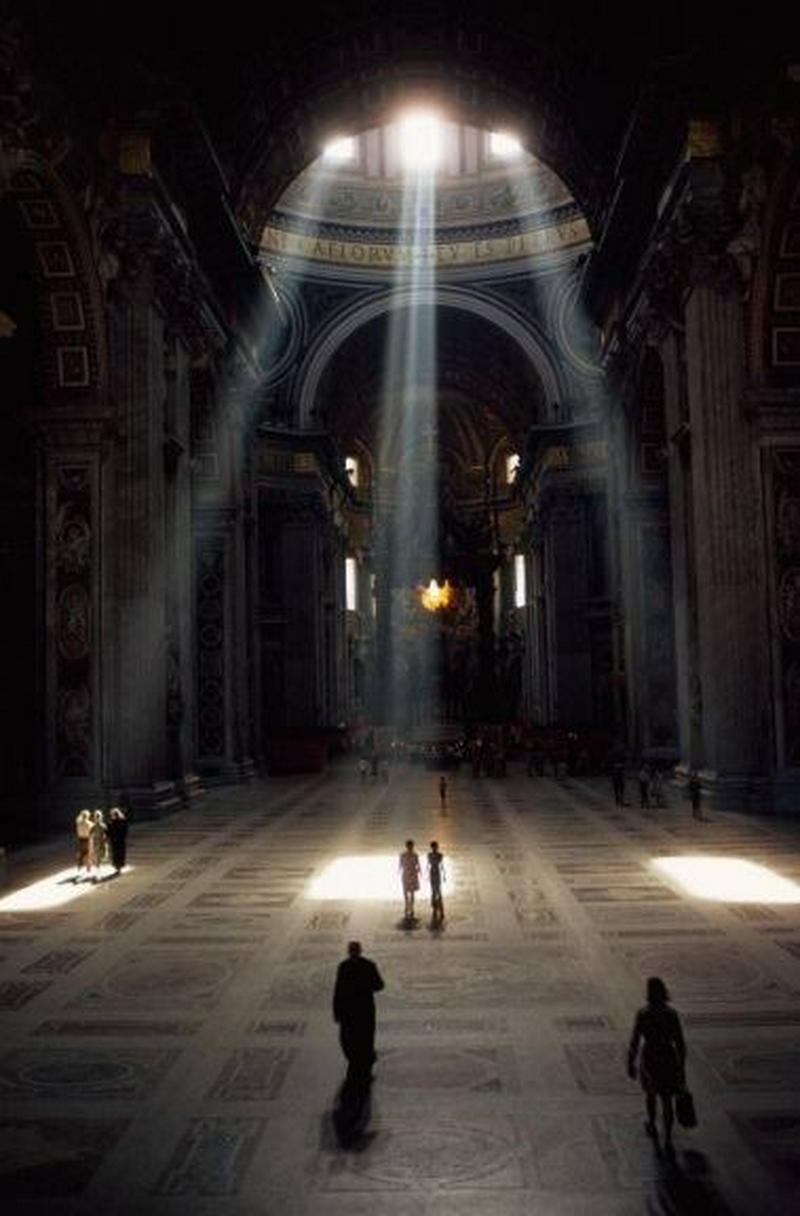Remarkable Man-Made Wonders of the World
By Sophia Maddox | April 17, 2024
Giza's Iconic Great Sphinx Continues to Mesmerize
There are over 100 million buildings in the world, an absolutely staggering number when you try to wrap your head around it. Before settling down and building structures, people were nomadic for thousands of years - of course this was 1.8 million years ago. Mostly, these buildings were simple structures consisting of four walls and a roof. Over time, people learned better techniques and started creating more elaborate structures, that's what we're checking out today.
From that time to the present, people have constructed many remarkable man-made structures. Some are lavish homes while others have been used as seats of government as well as other purposes. Let's look at some of these remarkable man-made structures.

Workers cut the original Great Sphinx of Giza from bedrock in about 2542 BC, but other workers have restored this statue on the west bank of the Nile River in Giza, Egypt, with limestone. This statue has the head of a human, with many experts suggesting it represents the head of Pharaoh Khafre, while the statue's body is a mythical creature, like a lion. The Great Sphinx received that name about 25 AD.
Likely, the head of the Great Sphinx of Giza was initially formed by blowing winds hitting the bedrock. Then, workers carved the head. Later, they built a moat around the head and workers used the removed bedrock to construct the statue's body. Evidence suggests that the Great Sphinx of Giza originally had a nose chiseled off before 1737, but no one knows by who or why they would have taken the nose as a souvenir. The statue probably had a beard although it may have been added later. In 1980, a rear passage into the Great Sphinx of Giza was unearthed, suggesting the statue may have originally been intended as a funerary.
India's Taj Mahal Captivates Anew

The Taj Mahal on Yamuna River's shore in Agra, Uttar Pradesh, India, was commissioned by Mughal Emperor Shah Jahan to house the tomb of his wife, Mumtaz Mahal, who died in 1631 while giving birth to the couple's 14th child. Architect Ustad Ahmad Lahori led a crew of 20,000 workers to construct the main building in 1643 but work on surrounding buildings continued until about 1653.
The main building's onion dome, which stands 115 feet tall, makes this one of the most recognizable sites in the world. The outside of the building contains marvelous examples of Mughal architecture created by artists using paint, stones and stucco. Its interior has many examples of lapidary made with precious and semi-precious gemstones. Sixteen sunken gardens surround the main building, with gardeners labeling most plants with their scientific names. Red sandstone walls enclose the main complex on three sides, with smaller mausoleums containing the emperor's other wives and his favorite servant near the walls.
Angkor Wat in Cambodia Continues to Capture Hearts With Its Timeless Splendor

Covering over 400 acres, Angkor Wat is the largest religious complex in the world. The temple's design is supposed to look like Mount Meru, the home of the Hindu gods, and many of the towers are precisely positioned to align with the solstice at sunrise. The walls and moat symbolize the surrounding mountain ranges and ocean, while the towers represent the mountain peaks. Workers used about 7.5 million sandstone blocks weighing about 1.5 tons each to build the five original towers. They covered almost every surface, including the roof, with carvings based on Indian literature.
King Suryavarman II had workers start constructing this sandstone complex near Angkor, Cambodia, during the 12th century as a Hindu temple dedicated to the god Vishnu. A Hindu religious leader named Divākarapaṇḍita urged King Suryavarman II to have the structure constructed. While debatable, the complex may have been the king's funerary temple. Starting in 1177, after the Chams gained control of the area, Angkor Wat was converted to a Buddhist temple in honor of King Jayavarman VII's wife.
The Great Pyramid of Giza Stands Tall as a Timeless Wonder of Human Achievement

Workers toiled for almost 30 years during the first half of the 26th century BC to construct the Great Pyramid of Giza, the largest Egyptian pyramid. It is the final resting spot of Pharaoh Khufu, the second ruler of the Fourth Dynasty of the Old Kingdom. This pyramid is the northernmost pyramid in the Giza Pyramid Complex. For more than 3,800 years, it was the tallest man-made structure in the world. When visitors see the Great Pyramid of Giza, they view the inner part of the pyramid as limestone originally covered the exterior. The pyramid consists of three chambers, with the lowest chamber below ground.
Workers used approximately 2.3 million blocks, each weighing about 2.5 tons, to construct the pyramid. They took the stone from a nearby quarry, but workers brought other materials from over 500 miles away. The corners of the pyramid roughly align with the four geographic cardinal directions, an achievement that still boggles the minds of scholars to this day.
The Great Wall of China Remains an Icon of Human Ingenuity and Tenacity

Workers constructed the Great Wall of China across the historical northern borders of ancient Chinese states and Imperial China as fortifications against nomadic groups. The earliest parts of the wall date back to the 7th century BC while the newest parts date to about 200 BC. According to the National Cultural Heritage Administration of China, the wall is 13,170.70 miles long, an undeniably impressive length. From its start near Dunhuang, Gansu, China, to its end at the Bohai Sea, there are 10,051 wall sections, 1,764 trenches, 29,510 individual buildings and 2,211 defensive fortifications.
The oldest parts of the wall are built from earth, but in about 1368, the workers started using lime or stone bricks that they often held in place with sticky rice mortar. Workers used mud to construct the western part of the wall. More recently, workers have reconstructed many of the areas near major tourist destinations.
Discover the Timeless Elegance of Petra, Jordan

The Nabataeans had settled in Petra, Jordan, by the 2nd century BC, and they were famous for creating a desert city of unique rose-colored sandstone quarried from the local hills. Workers built dams, cisterns and water conduits to control water, allowing them to store it for prolonged periods of drought.
The city contains many examples of Hellenistic architecture. The most significant monument in Petra is the monastery, measuring 148 feet tall and 160 feet wide. The Al-Khazneh treasury is the most elaborate building. This structure at the narrow end of the Sig Gorge contains hundreds of bullet holes put there by local Bedouin tribes who believed the structure contained great riches. Nearby is the theater, positioned so that visitors can see most of the tombs. Also nearby is the Petra Pool and Garden Complex, which contains a large swimming pool, an island pavilion and an intricate hydraulic system.
Machu Picchu, Peru, Remains a Beacon of Inca Ingenuity

Machu Picchu and its three primary structures can be found in the Sacred Valley, about 50 miles northwest of Cusco, Peru. There is no written record of its construction, but archeologists believe workers built it about 1450 as the estate of Inca Emperor Pachacuti. About 750 people from diverse backgrounds across Peru appear to have lived at Machu Picchu until about 1530.
Workers constructed hundreds of terraces to ensure good drainage as the residents used the area for growing corn and potatoes. Evidence suggests that a lot of the food was brought in from surrounding areas, using llamas. Archeologists believe the estate initially had about 200 buildings arranged around a central square. They have unearthed a religious zone containing the Intihuatana, the Temple of the Sun and the Temple of the Three Windows, a residential section where lower-class residents lived and a royalty area where nobility lived in trapezoid-shaped rooms.
Brazil's Christ the Redeemer Towers as a Symbol of Faith and Architectural Splendor

Paul Landowski designed the Christ the Redeemer statue that towers over Rio de Janeiro, Brazil. Including its pedestal, the statue is 124 feet tall. This statue on Mount Corcovado in Tijuca National Park that depicts Jesus Christ is 92 feet wide. It weighs 635 tons. In 1920, Brazilian Catholics raised about $250,000 to have the statue built, starting in 1922. Government officials chose the statue's design and extensively modified it to represent the country's religious roots and celebrate its 100th anniversary of independence from Portugal.
Workers used concrete from Limhamn, Sweden, to build the statue's base layer, which they covered with soapstone. In all, workers spent more than nine years constructing it. Restoration work has occurred many times due to the sheer volume of lightning strikes that have occurred over the last century.
Egypt's Pyramids Are Timeless Marvels Along the Nile

Archeologists have found more than 115 Egyptian pyramids. They believe workers constructed the first of these pyramids about 2630 BC. Many of the stones used to build the pyramids came from local bedrock. Experts suggest that the sand was wetted so that less friction was created, and the blocks were pulled to the site on wooden sleds. Some pyramids contain materials that workers transported on the Nile. Historians believe the people thought the pharaohs would use the pyramid shape as a staircase to get direct access to heaven.
Many pyramids look like a pile of rubble, but some are considered more important than others. Of these pyramids, the tallest, besides the Great Pyramid of Giza, is the pyramid of Khafre, standing 448 feet tall. Workers constructed it about 2500 BC. They may have used stones removed while building this pyramid to create the body of the Great Sphinx of Giza.
Italy's Iconic Colosseum Is a Gladiatorial Marvel That Stands Proud

Despite construction starting in 70 AD, the Colosseum in Rome is the largest amphitheater ever built . Emperor Vespasian ordered workers to begin building the limestone, volcanic rock and brick-faced concrete amphitheater, and it took them over 10 years to finish. Experts generally assume that many of those workers were Jewish prisoners of war who officials returned to the city following the First Jewish–Roman War.
Workers constructed the outer walls of the Colosseum of about 3.5 million cubic feet of stone held together by 300 tons of iron clamps. Initially, the Colosseum had a retractable awning that people could position to provide shade and a breeze for spectators. The Colosseum had 80 entrances so that spectators could quickly enter and leave the facility.
Seating in the elliptical Colosseum was by class. The king and Vestal Virgins were seated on the north and south ends, so they got the best views, while senators were seated along the sides. Above them, the non-senatorial noble class or knights were seated while ordinary citizens were seated above them.
Stonehenge's Enduring Mystery Continues to Intrigue

Stonehenge on the Salisbury Plain near Amesbury, Wiltshire, England, consists of an outer ring of stones, each standing about 13 feet tall and 7 feet wide. Each stone weighs about 25 tons. They are topped with vertical stones, connecting them. There are two smaller rings of stones located inside the outer ring. An earth bank and ditch surround the outer ring, and archeologists believe workers constructed the ditch about 3100 BC while placing stones at the site from 3000 BC to 1600 BC. It is likely workers built the monument in several different phases.
Mike Parker Pearson, a leader with the Stonehenge Riverside Project, said:
Stonehenge was a place of burial from its beginning to its zenith in the mid-third millennium BC. The cremation burial dating to Stonehenge's sarsen stones phase is likely just one of many from this later period of the monument's use and demonstrates that it was still very much a domain of the dead.
The Acropolis of Athens Is a Testament to Greek Civilization

Workers constructed buildings on the flat terrace now home to the Acropolis of Athens, Greece, including the Parthenon, starting about 10,000 BC. Workers reconstructed most of the area in about 460 BC under orders issued by Pericles. Reconstruction efforts continued during the Hellenistic, Roman, Byzantine, Frankish, and Ottoman periods, including erecting statues to foreign gods. Still, most statues were removed after Greece became independent in the 1840s.
Visitors to the Acropolis of Athens can see several buildings and statues. The Temple of Athena Nike stands near the south entrance, which workers constructed about 420 BC. This temple dedicated to the god of victory is the earliest fully Ionic temple on the Acropolis. Visitors can also see the Erechtheum, which may have been dedicated to King Erechtheus and designed by Mnesicles. The Parthenon is at the center of the complex, dedicated to the goddess Athena during the fifth century BC.
The Eiffel Tower in Paris Shines as a Symbol of Architectural Romance

The wrought-iron lattice Eiffel Tower is named after Gustave Eiffel, whose company is responsible for its construction between 1887 and 1889 as a centerpiece for the 1889 Paris Exposition. The tower, which stands 1,083 feet tall, was the tallest man-made structure in the world at the time of its construction. It consists of three levels, with the upper level containing an observation deck while the other two levels have restaurants.
Many leading French artists protested constructing the Eiffel Tower because they thought the design infeasible, but it opened to the public on May 26, 1889. Over 30,000 people paid up to five francs to climb the 1,710 steps to the tower's top because workers still needed to install the elevator. Even though the original contract given to Eiffel called for removing the tower in 20 years, the attraction became so successful that it still stands today.
Moai Statues Guard the Secrets of a Remote Pacific Island

The Rapa Nui people living on Easter Island carved monolithic human figures with exaggerated heads between 1250 and 1500. Workers cut about 50% of the 900 Moai statues in a nearby quarry, but they transported the other half from nearby locations. Almost 95% of the Moai statues are made from volcanic rock, but 22 are from trachyte, 17 are from red scoria, and 13 are from basalt.
Scientists from the University of California working with the Easter Island Statue Project believe that people carved the statues to ask their ancestors to help them produce food. While the remaining land on Easter Island was considered poor for growing crops, the work at the Rano Raraku Quarry where about 95% of the statues were made was rich in minerals needed for growing crops and had a constant water supply.
Rome's Pantheon Echoes With Millennia of Cultural Grandeur

While there is some debate, workers likely constructed a building where the Pantheon currently stands on the site before Marcus Agrippa had a temple built about 27 BC. While soldiers destroyed all or part of the original temple, workers under the direction of Emperor Phocas reconstructed the building. They presented it to Pope Boniface IV on May 13, 609, who dedicated it to St. Mary and the Martyrs.
The Pantheon is the oldest building in the world still in regular use. Since it was a church, soldiers did not desecrate like other older Roman buildings. The Pantheon has the largest brick dome in the world. This building was the first to have an inner chamber and has served as an example for many other Roman buildings.
Discover the Timeless Tapestry of Maya Mastery and Astronomical Wonder at Chichen Itza, Mexico

The city of Chichen Itza probably served as home to the rulers of Central Mexico, starting in about 600 and lasting through the early part of the 1400s. The Mayan city covered an area of about 1.5 square miles.
The site consists of a series of smaller areas separated by low walls. One of the most notable is the Great North Platform, dominated by a step pyramid, identified as the Temple of Kukulcán. When visitors clap their hands near this temple, they hear a chirp-like tone similar to a bird's call. It also contains the Great Ball Court, the largest and best-preserved ball court in ancient Mesoamerica. Residents probably played pok-a-tok on it, which is like racquetball. A short distance north of the ball court is the Temple of the Bearded Man. This temple contains a drawing that looks like a man shaving his face.
Mount Rushmore's Granite Giants Commemorate American Greatness

Sculptor Gutzon Borglum designed Mount Rushmore, located near Keystone, South Dakota, in the Black Hills, based on an idea by Doane Robinson, the Secretary of the South Dakota State Historical Society. Borglum also oversaw the carving of George Washington, Thomas Jefferson, Theodore Roosevelt, and Abraham Lincoln's heads on the hill until his death in March 1941, when his son took over the project. Originally, Borglum intended to carve each man's image down to his waist, but funding ran out, so only Washington is shown lower than the chin.
Over 400 men worked on creating the carvings from October 4, 1927, to October 31, 1941. Carving the memorial was a challenge. Each day, they had to climb 700 stairs to the top of the monument to punch in for work. Then, they were lowered on steel cables to begin their work, often using dynamite to blast away part of the mountain.
Hagia Sophia Grand Mosque Is Istanbul, Turkey's Eternal Gem

Byzantine Emperor Justinian I oversaw the Hagia Sophia Grand Mosque construction from 532 to 537. When the building officially named the Church of God's Holy Wisdom was completed, it had the world's largest interior space. It was the largest cathedral until the completion of the Seville Cathedral in 1520. The building was the seat of the Eastern Orthodox faith from 360 to 1204 when it became a Catholic church. It returned to being an Eastern Orthodox temple in 1234 and remained one until 1453 when it became a mosque. The building was used as a museum from 1935 until 2020 when it became a mosque again.
The building is considered the first example of Byzantine architecture, and one of its best surviving examples. The main dome, which measures 107 feet in diameter, was the largest pendentive dome in the world until the completion of St Peter's Basilica.
The Stupendous Buddhist Legacy of Borobudur, Indonesia

Borobudur, located near Magelang, Central Java, Indonesia, is the largest Buddhist temple in the world. The temple built in the 9th century consists of six square and three circular stacked platforms, topped by a central dome. Workers quarried about 72,000 cubic yards of andesite stones to build the structure, which they constructed without using mortar. Guides lead visitors through stairwells and corridors past 1,460 narrative relief panels and 1,212 decorative panels. The square-stacked platform and the top platform contain several Buddhas seated in a lotus position.
Borobudur was abandoned for a while but no one is sure how long. In 1907, restoration work began on the site that had been encroached on by the jungle. The building now hosts worship services during Vesak, when many Buddhists in Indonesia believe that Siddhārtha Gautama achieved enlightenment.
The Regal Magnificence of the Palace of Versailles

King Louis XIV commissioned workers to construct the Palace of Versailles in Versailles, France. The structure began as a simple hunting lodge before being expanded by King Louis XIII and rebuilt by King Louis XIV between 1661 and 1715 to become the royal residence. It was abandoned during the French Revolution before Napoleon used it as a summer residence from 1810 to 1814. Mozart performed in the palace and dedicated two sonnets to it. In 1783, officials from Great Britain, Spain and France signed treaties at this location, ending the American Revolutionary War. Government officials signed the Treaty of Versailles in 1919, which ended World War I.
The Palace of Versailles covers more than 2,000 acres. South, west and north of the palace are gardens replanted in 1999, following a devastating December storm. The estate also contains numerous subsidiary structures, dating back as early as 1662.
Alhambra's Moorish Splendor Continues to Enchant Visitors

In 1238, Muhammad I Ibn al-Ahmar told workers to begin constructing the Alhambra in Granada, Andalusia, Spain. It's unclear if he knew that the complex would grow to be a self-contained city with at least six significant palaces on its north side. Three of those palaces remain major tourist attractions today.
Comares Palace was constructed during the 14th century, and one of the significant parts of this palace is the Court of Myrtles, with its beautiful reflective pool in its middle. The Palace of the Lions was constructed during the last part of the 15th century. Visitors enjoy seeing the marble Lion fountain, with 12 sculptured lions facing outward holding a water basin on their back, which may have been sculpted from a single piece of marble about 1100. The third palace is the Partal Palace. Only the portico and the tower of this palace that workers built in the early 14th century remain.
The Leaning Tower of Pisa, Italy

The Leaning Tower of Pisa is at the Pisa Cathedral in Pisa, Italy. There is a longstanding debate about who designed this bell tower that leans about four degrees because workers constructed it on soft ground during the 12th century. The soft ground could not support the weight of the bell tower, which stands 185 feet 11 inches tall on its tall side and 183 feet 3 inches on its short side. The tower began to sink in 1173.
It took workers 199 years to build the Leaning Tower of Pisa because workers built it in three phases. The last bell, the seventh, was installed in 1655. Several attempts have been made to restore the Leaning Tower of Pisa, including one in 1990, which removed dirt from under the bell tower's high side.
San Francisco, California's Golden Gate Bridge Adds Beauty to the City

Joseph Strauss was chief engineer when the Golden Gate Bridge was constructed in 1937. It took him most of a decade to drum up support for the bridge before construction could begin. The United States Department of Defense, the US Navy and the Southern Pacific Railroad opposed the suspension bridge project. Even though these influential groups opposed its construction, voters approved selling bonds to create the bridge. Still, they had trouble finding a bond buyer, until the founder of Bank of America stepped up and purchased all the bonds.
Construction of the bridge began on January 5, 1933. In order to keep workers safe, a safety net was placed above San Francisco Bay. Despite their best efforts, 11 men were killed during its construction because they broke through the safety net when the scaffolding they were standing on gave way. The bridge finally opened on May 27, 1937.
Serenely Navigating the Timeless Charm of Venice Canals

Venice, Italy, is home to 150 canals that visitors and residents use for emergency services, gondola rides and water taxis. About 120 of those canals are not man-made. They fill gaps between the land masses in this city.
There are three major canals. The Grand Canal runs about two miles from Piazzale Roma in the city's historic center to the Venetian Lagoon, the busiest canal. The second canal is the Giudecca Canal, which runs from the middle of the city to the Marittima cruise basin and is a major shipping route. Since it is near the port where many tourists arrive by boat, it is often the first canal tourists see. The third major canal is the Cannaregio Canal, which people see when they walk across the Ponte delle Guglie Bridge.
Vatican City Is a Timeless Epicenter of Faith, Art, and Papal Majesty

Vatican City is an independent country, city-state, microstate, and enclave within Rome, Italy. The complex consists of several important buildings. St. Peters Basilica has the largest interior of any church in the world. Construction on this building started on April 18, 1506, and finished on November 18, 1626. The city is also home to the Sistine Chapel, where Michelangelo created his amazing ceiling frescoes.
The city that covers over 100 acres is also home to several Vatican museums, which contain some of the most important art pieces. The Pio-Clementine Museum, which opened in 1932, includes 10 galleries of Roman sculptures. The Chiaramonti Museum, which opened in about 1807, showcases many Neo-classical sculptures. Vatican City is also home to the Gregoriano Profano Museum, which opened in 1970 and contains many items from Roman antiquity.
Neuschwanstein Castle Beckons With Bavarian Majesty

Neuschwanstein Castle is in Schwangau, Bavaria, Germany. Workers constructed it as the private residence for King Ludwig II of Bavaria, but he died before he ever got to move into it. Shortly after his death, the government opened the castle to the public on August 1, 1886. From about 1868, when construction began, to its opening, most men in the region worked at creating the castle, which was to serve as a home to Bavarian monarchs. King Ludwig II of Bavaria envisioned a castle containing over 200 rooms, but workers only finished 15 rooms.
The castle contains many modern inventions that were unique for the time. For instance, it had a bell system that workers could use to communicate with each other. It also had warm running water. The kitchen had a Rumford oven, where help cooked food on a skewer. The oven automatically adjusted the skewer's turning speed based on the oven's temperature.
Silent Guardians of Ancient Majesty – China's Terracotta Army

Discovered in 1974, China's Terracotta Army is a form of funerary art buried with the country's first emperor in the late 200s BC. Local farmers and archeologists have found about 8,000 soldiers, 130 chariots with 520 horses, and 150 cavalry horses in three pits near Xi'an, Shaanxi, China. In addition, they have discovered terracotta statues of officials, acrobats, strongmen and musicians. Up to 70,000 workers may have been employed to create the statues. Most of the statues remain buried in the pits. Workers at each pit were responsible for creating a particular type of statue.
The human statues vary in height with the generals being the tallest and those of lower rank being smaller. Historians believe artisans designed the statues to protect the emperor in his afterlife.
Unveiling the Ingenious Legacy of the Roman Aqueducts

Roman officials ordered workers to build the first aqueduct in 312 BC. These systems worked by gravity, moving water from a higher point to a lower one. Most of the aqueduct system runs underground, but workers constructed bridges and other structures where it was impossible to help the water move along.
Available water was used on a rationing system. The priority was to deliver water to Rome's more than 2,000 public fountains, where people could bring a bucket to get water. Then, the remaining water went to public baths. Next in line were wealthy citizens. Finally, industries got water.
Decoding the Secrets of the Pyramids of Teotihuacan

The Pyramids of Teotihuacan are about 25 miles northeast of Mexico City. During the first half of the first century, this area covering about eight square miles was considered the most advanced in the Americas. Teotihuacan's main buildings lie along the Avenue of the Dead. At its northern end was the Pyramid of the Sun, the largest structure in Teotihuacan. Located about 0.5 miles away, the Pyramid of the Moon was the second-largest structure. The structures were discovered only centuries after the city was abandoned. The top of the cave aligns with the sun's position on the equinoxes, and researchers believe that an altar was initially located there.
The Pyramid of the Sun stands 233.5 feet tall. Under the pyramid is a series of tunnels leading to caves that researchers believe the residents considered sacred. They discovered one cave under the pyramid, which they believe could have been a royal tomb.
Embark on a Journey Through China's Forbidden City

China's Forbidden City lies at the center of the Imperial City of Beijing. Workers constructed it between 1406 and 1420 as the emperor's imperial palace and winter residence during the Ming Dynasty. The complex, covering over 178 acres contains over 980 buildings, the largest collection of preserved ancient wooden structures worldwide. It is also considered the world's most valuable palace and most valuable piece of real estate.
More than 1 million workers were employed over 14 years to build the Forbidden City. The complex was home to 14 Ming Dynasty and 10 Qing Dynasty emperors. There are three main buildings in the Forbidden City's Inner Court. The Palace of Earthly Tranquility is where the emperor entertained his new wife shortly after marriage. The Palace of Heavenly Purity is the largest in the Inner Court, and it is where the emperor usually lived. The last main building is the Hall of Union, where the emperor often performed official duties.

